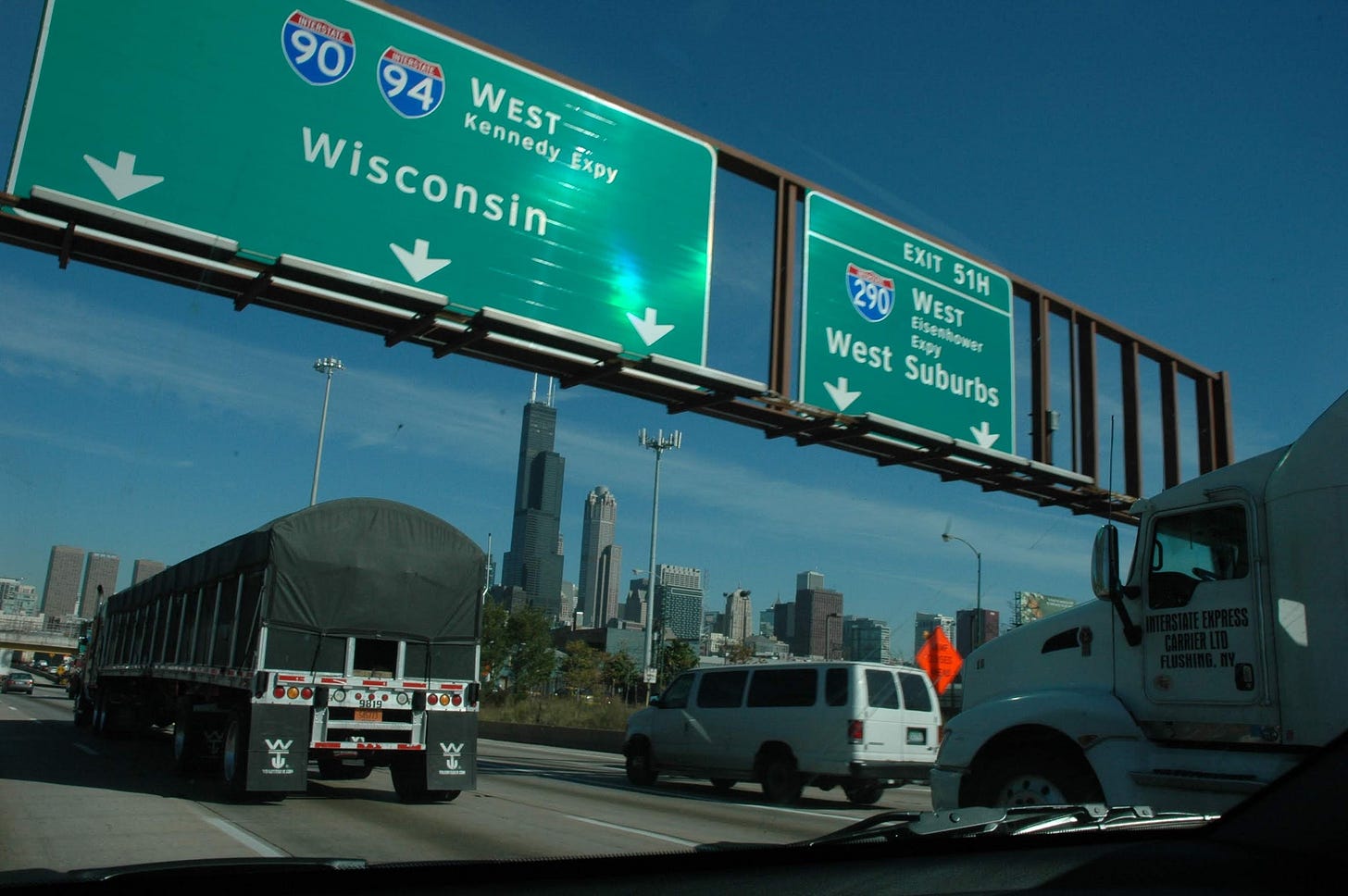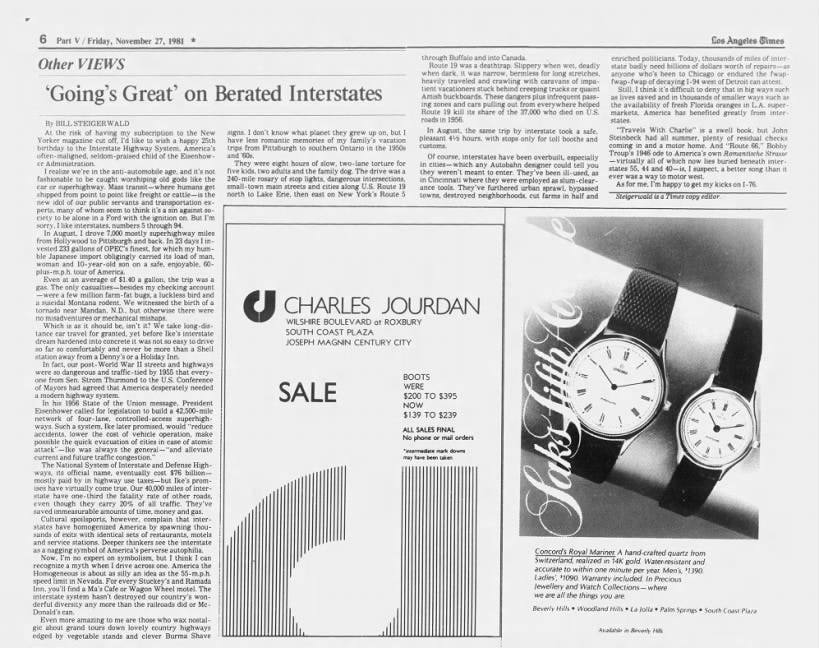Paying my respects to the interstates
When I said happy 25th birthday to our interstate system in I981 and praised its benefits to drivers and America, I previewed opinions I'd put in my 2012 book about Steinbeck's 'Travels with Charley.'
Other Views
'Going's Great' on Berated Interstates
Los Angeles Times View section
Nov. 27, 1981
At the risk of having my subscription to the New Yorker magazine cut off, I'd like to wish a happy 25th birthday to the Interstate Highway System, America's often-maligned, seldom-praised child of the Eisenhower Administration.
I realize we're in the anti-automobile age, and it's not fashionable to be caught worshiping old gods like the car or superhighway.
Mass transit — where humans get shipped from point to point like freight or cattle — is the new idol of our public servants and transportation experts, many of whom seem to think it's a sin against society to be alone in a Ford with the ignition on. But I'm sorry, I like interstates, numbers 5 through 94.
In August, I drove 7,000 mostly superhighway miles from Hollywood to Pittsburgh and back. In 23 days I invested 233 gallons of OPEC's finest, for which my humble Japanese import obligingly carried its load of man, woman and 10-year-old son on a safe, enjoyable, 60-plus mph tour of America.
Even at an average of $1.40 a gallon, the trip was a gas. The only casualties — besides my checking account — were a few million farm-fat bugs, a luckless bird and a suicidal Montana rodent. We witnessed the birth of a tornado near Mandan, N.D., but otherwise there were no misadventures or mechanical mishaps.
Which is as it should be, isn't it? We take long-distance car travel for granted, yet before Ike's interstate dream hardened into concrete it was not so easy to drive so far so comfortably and never be more than a Shell station away from a Denny's or a Holiday Inn.
In fact, our post-World War II streets and highways were so dangerous and traffic-tied by 1955 that everyone from Sen. Strom Thurmond to the U.S. Conference of Mayors had agreed that America desperately needed a modern highway system.
In his 1956 State of the Union message, President Eisenhower called for legislation to build a 42,500-mile network of four-lane, controlled-access superhighways.
Such a system, Ike later promised, would "reduce accidents, lower the cost of vehicle operation, make possible the quick evacuation of cities in case of atomic attack" — Ike was always the general — "and alleviate current and future traffic congestion."
The National System of Interstate and Defense Highways, its official name, eventually cost $76 billion — mostly paid in highway use taxes — but Ike's promises have virtually come true.
Our 40,000 miles of interstate have one-third the fatality rate of other roads, even though they carry 20% of all traffic. They've saved immeasurable amounts of time, money and gas and have relieved congestion in many areas.
(This paragraph was cut by the Times’ editors):
Despite such obvious benefits to society, none of the political or media fanfare so common to our times has marked the 25th birthday of the interstate. The interstate system, an intra-continental system of transit for the masses if ever there was one, is as un-chic as the internal combustion engine.
Cultural spoilsports, however, complain that interstates have homogenized America by spawning thousands of exits with identical sets of restaurants, motels and service stations. Deeper thinkers see the interstate as a nagging symbol of America's perverse autophilia.
(This paragraph was cut by the Times’ editors):
(You remember the car. Once the epitome of the freedom and mobility available to every American, in the mass-transit age, the car symbolizes selfishness, pollution and wasted energy resources.)
Now, I'm no expert on symbolism, but I think I can recognize a myth when I drive across one.
America the Homogeneous is about as silly an idea as the 55-mph speed limit in Nevada. For every Stuckey's and Ramada Inn, you'll find a Ma's Cafe or Wagon Wheel motel. The interstate system hasn't destroyed our country's wonderful diversity any more than the railroads did or McDonald's can.
Even more amazing to me are those who wax nostalgic about grand tours down lovely country highways edged by vegetable stands and clever Burma Shave signs.
I don't know what planet they grew up on, but I have less romantic memories of my family’s vacation trips from Pittsburgh to southern Ontario in the 1950s and 1960s.
They were eight hours of slow, two-lane torture for five kids, two adults and the family dog. The drive was a 240-mile rosary of stoplights, dangerous intersections, small-town main streets and cities along U.S. Route 19 north to Lake Erie, then east on New York’s Route 5 through Buffalo and into Canada.
Route 19 was a deathtrap. Slippery when wet, deadly when dark, it was narrow, bermless for long stretches, heavily traveled and crawling with caravans of impatient vacationers stuck behind creeping trucks or quaint Amish buckboards.
These dangers plus infrequent passing zones and cars pulling out from everywhere helped Route 19 kill more than its share of the 37,000 who died on U.S. roads in 1956.
In August( of 1981), the same trip by interstate took a safe, pleasant 4½ hours, with stops only for toll booths and customs.
Of course, interstates have been overbuilt, especially in cities — which any Autobahn designer could tell you they weren't meant to enter.
They've been ill-used, as in Cincinnati where they were employed as slum-clearance tools. They've furthered urban sprawl, bypassed towns, destroyed neighborhoods, cut farms in half and enriched politicians.
Today, thousands of miles of interstate badly need billions of dollars worth of repairs — as anyone who's been to Chicago or endured the fwap-fwap-fwap of decaying I-94 west of Detroit can attest.
Still, I think it's difficult to deny that in big ways such as lives saved and in thousands of smaller ways such as the availability of fresh Florida oranges in L.A. supermarkets, America has benefited greatly from interstates.
"Travels With Charlie" *** is a swell book, but John Steinbeck had all summer, plenty of residual checks coming in and a motor home. And "Route 66," Bobby Troup's 1946 ode to America's own Romantische Strasse — virtually all of which now lies buried beneath interstates 55, 44 and 40 — is, I suspect, a better song than it ever was a way to motor west.
As for me, I'm happy to get my kicks on I-76.
Steigerwald is a Times copy editor.
*** Hilariously, considering that in 2012 I wrote a whole book, Dogging Steinbeck, that exposed the many fictions and lies John Steinbeck put into ‘Travels with Charley,” I misspelled ‘Charley’ in this commentary and not one of my fellow copy editors saved me.





One good read, and all very true. Eisenhower had to take a convoy of trucks across the country on those primitive bad roads long before the Second World War. He remembered, and when he had the power to do something about it, he did.